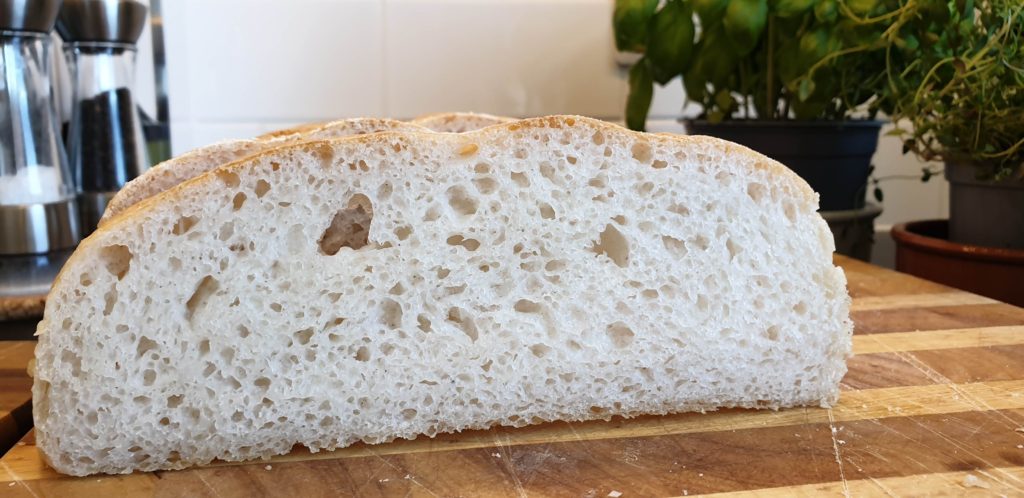Easy Gluten Free Sourdough Starter
This easy gluten free sourdough starter will transform your life! Making your very own gluten free sourdough starter is possible and just as simple as starting (and baking) a traditional sourdough bread. This gluten free sourdough starter is a low fuss and lovely way to get your very own Starter going so you too, can jump on the sourdough bandwagon this summer!

Notice nice big air pockets 
Thick and bubbly
Let’s start with the basics. Sourdough bread is as old as life itself. People have been making bread for thousands of years using nothing but flour, water and the magical rising agent – natural airborne yeasts. How else were our ancestors able to make bread before the introduction of Whole Foods and Instant Yeast!
By capturing these little yeasty beasties and allowing them to develop in the right environment, one is left with a delicious smooth blend of starter which is sweet, sour and full of natural gases which gives bread its rising agent and lovely flavour.

You can definitley go old school and slowly develop and mature a starter from scratch. This recipe, however, jump starts the fermentation process by injecting the good bacteria from Kefir water. Just a couple tablespoons is enough to get you addicted to a brand new hobby and love for bread – sourdough!
The process is pretty much the same as with conventional flours. The bacteria feed off the sugars and proteins of the grains. Unlike wheat, gluten free flours carry different levels of each and absorb water differently and contain different levels of sugar. So this method is a guide only and you’ll need to add you intuition and common sense into the mix.

Some gluten free flours like buckwheat will not work well, white rice seems to perform better. At the end of the day, whatever you feed your starter to thrive is imperative. Also, ensuring you are handling the starter is just as important. A common complaint for first timers and even those with buns under their belts is mold. It’s very easy for the bad bacteria to get in on the sourdough party and wreck it for everyone. If you find mold, your started is a bust. Gotta start over!
But this no fuss recipe should help get you up and running soon, so the most difficult thing you’ll need to do is come up with a name for your starter. Yay!!!! I call mine Fred.
Ingredients
1/2 cup gluten free flour blend
1/2 cup unfiltered or bottled water
2 Tablespoon Kefir water*
Daily Feeding – every 12 hours
1/4 cup gluten free flour blend
1/4 cup unfiltered or bottled water
*finding plain Kefir water seems to be an impossible feat. I’ve experimented using various Kefir water types and they’ve worked well. Such a small amount is needed, don’t worry if all you can find is flavoured Kefir, or even Coconut Kefir. It’s the bacteria you need and by the time the starter has been fed and re-fed over the week, there will be no trace of flavor to concern yourself with. In the recipe, all I could find was flavored coconut Kefir which worked a treat!
In a clean, sterilized jar add 1/2 cup of gluten free flour. Try to find one with a good blend of rice and other high starch flours. I have recently discovered Caputo 00 gluten free flour which, in my opinion, is a total game-changer when it comes to gluten free flour. But if in a pinch, rice flour should work well too.
Mix flour with equal parts of bottled water, plus two Tablespoons of Kefir water. If at all possible you want to avoid tap water as this can be full of chlorine or chemicals which will kill your healthy bacteria (why it’s been put in the tap water in the first place – to kill the bugs!).
Here’s where common sense comes into play. You don’t want a thick paste, or do you want a thin runny sauce. Something in between. Think of ice cream that has melted but not completely thawed. Don’t worry too much about it though. After a few days you’ll see how the starter responds. The type of flour, temperature and how well the starter takes will depend on how it performs.
Cover with a lid or cling film/cloth and elastic. We want to keep the bad bugs out but let it breath if it needs too. Over the next few days gases will start to form so having a tiny escape route for them is a good idea. I use fermenting jars (see affiliate link below). These jars are great because they let allow the air to flow out of the jar, but prevent any new air in which could contain bad bacteria.
Feeding your starter. The reason the gases exist and the starter becomes strong is that over 5 – 7 days, it is getting ongoing food to grow. Similar to your car, it needs fuel and the gluten free sourdough needs new flour and water to keep it charged. So every day, discard half the starter (down the sink!) and replace with an equal mixture of gluten free flour and bottled water. Keep doing this every day, at the same time. If for some reason you can’t, place your starter in the fridge and the cooler temperature will slow down the fermenting process.
Important: Mold is a nasty culprit that can easily penetrate your starter and cause havoc. If you find mold, you have to start over again. So when you feed your starter, pour everything into a new, clean jar to minimize any bad bugs. The joy of using Kefir is that the fermenting time from start to finish is half the time of conventional starters, so as such, reduces the chances of mold.
In the initial few days, the water might naturally start to separate from the gluten free flour and float on top. This is most likely because you have too much water, or, the grains are not super absorbent. If this happens, I give it a good mix every so often to make sure the dry/wet mixture keeps in contact.
Each day, you’ll start to see more bubbles to form. You’ll notice that it starts to get thicker and bubbly. One day it will…..Poof! Be big, bold and full of foam. Give it a taste and it should have a nice signature sour flavour.
Once ready, you can use it or keep it alive as you have until you are ready.
A couple top tips:
Once your gluten free sourdough starter is mature, you can use the daily discard for other tasty treats like waffles, crepes and even banana bread! It’s full of flavour and can be used in your daily recipes!
Feeding your starter every day can be a pain and expensive with all the waste so you can keep in the fridge and feed only once every few days. Some people claim to keep their gluten free starter in the freezer which I’ve never tried, but if you keep super cool, you can extend the feeding time resulting in less maintenance.
Below you can find Amazon Affiliate links if you wish to purchase any of the things I’ve used in this recipe:
UK Links below:
USA Links below:
Related Posts





